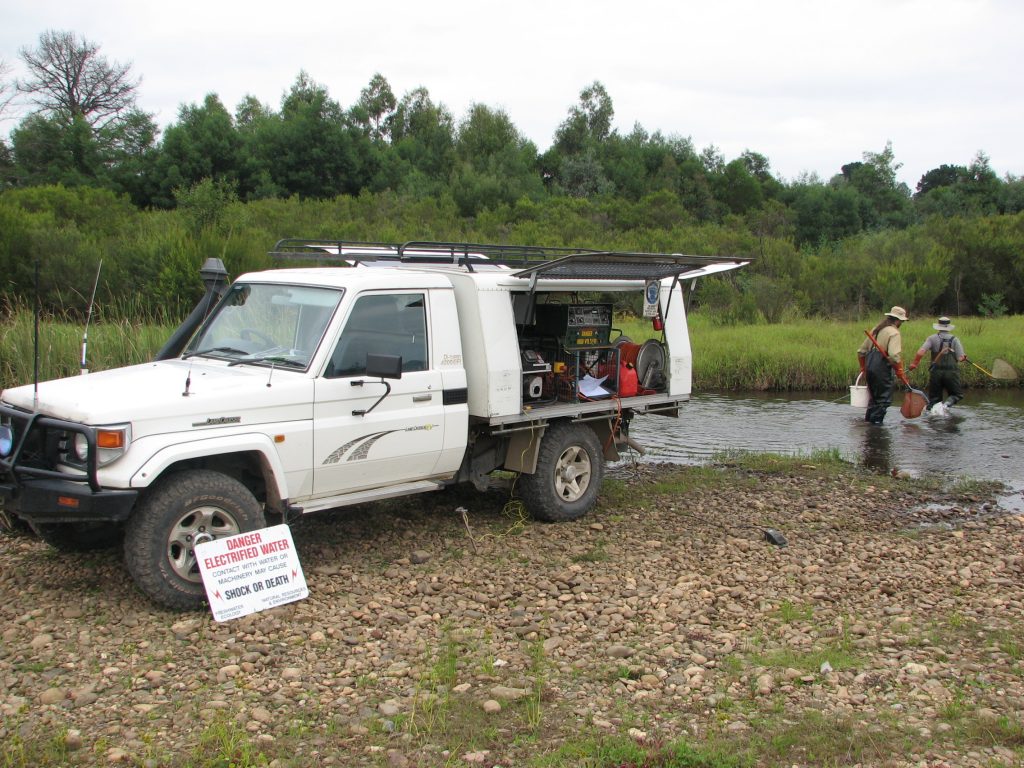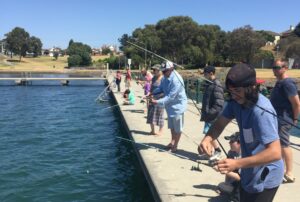October 19, 2015
By Renae Ayres, Arthur Rylah Institute for Environmental Research
We use a range of study tools to understand fish populations; how they function, how they respond to impacts, and how they respond to our efforts to help improve them. One of these study tools is ‘electrofishing’. Electrofishing is used by fish biologists to collect fish and gather information about fish populations, such as species distributions, abundances, diversity, size class distributions (showing recruitment or breeding success) and the presence of introduced or invasive species. It is used to assess and monitor recreational and threatened fish, as well as fish responses to, for example, habitat improvements, environmental flows, fish ‘ladders’, drought and bushfire impacts. Electrofishing provides vital fish data to inform fisheries and waterway management throughout Victoria and worldwide.
Electrofishing?! What is it?
Electrofishing involves the use of electricity to momentarily stun fish so that they can be caught, identified and measured for length and weight. In some instances, fish are also tagged with unique identification labels, transmitters to track fish or fin-clips are collected for genetic analysis. Fish recover quickly when removed from the electric field and are released back into their environment unharmed.

How does electrofishing work?
There are three main types of electrofishing units: backpack, bank-mounted and boat-mounted. All have a power source (battery or generator) to provide the electrical current, a control box to regulate the delivery of electricity to suit the specific survey, positive and negative electrodes which are suspended in the water and pass the electrical current through the water, and safety switches which immediately shut down power.
Each type of electrofishing unit differs in its application. Backpack electrofishing units are designed for use in wade-able habitat (e.g. smaller streams and wetlands) with low to moderate salinities. Backpack electrofishing units are literally carried on your back, so they can be used wherever you can walk through the stream and in more remote areas. Bank-mounted electrofishing units have a much higher power output and are operated via a generator mounted in a vehicle. They are also used in wade-able habitat and can be applied in moderate to high salinities, however you need to have the supporting vehicle nearby. Boat-mounted electrofishing is used to sample fish from larger sites that are navigable by boat, such as rivers and lakes, and in water depths greater than 0.5 metre. Until recently, boat-electrofishing was limited to fresh water, however German electrofishing manufacturer Hans Grassl and the Arthur Rylah Institute for Environmental Research (ARI) have developed a prototype boat-mounted electrofishing unit that has the capacity to operate in saline environments such as estuaries. The Grassl boat-mounted electrofishing unit is a great innovation which will help fill a significant gap in worldwide fish research by enabling more thorough studies of estuaries.
Fish responses
Fish react variously to electrofishing. Within the electric field, voltage is greatest near the unit’s positive electrode and decreases with distance. The size of the fish, its distance from the positive electrode, and its’ orientation to the electric field all influence the voltage that a fish is exposed to. At very low levels of voltage exposure, fish exhibit little or no reaction and may just swim away. Higher levels of voltage exposure can inhibit swimming, trigger forced – swimming towards the positive electrode, and/or temporary stunning. As stunning only lasts for a few seconds, the fish need to be quickly netted and placed into an insulated, holding tank of clean water for recovery, allowing a number of fish to be measured after the electrofishing operation is finished.
The effectiveness of electrofishing is influenced by many environmental, biological and technical factors, such as water depth, salinity and turbidity; the size, biology, behaviour and density of fish; the working environment, weather, gear type, staff experience, etc.
Is electrofishing better than netting?
Of all the various tools available to sample fish, electrofishing is the most commonly used. Its main advantages over conventional netting methods are that:
- Electrofishing allows capture of a range of fish species and sizes
- Electrofishing can be used in a variety of habitats, whereas netting becomes tangled amongst reeds, logs and other instream habitats
- Electrofishing is more efficient: it takes less time and less effort
- Electrofishing is more scientifically ‘rigorous’: it allows a greater standardisation of catch per unit effort
- If properly used, adverse effects on fish are minimised
- Unlike netting, electrofishing does not rely on the movement of fish to be effective.

Who uses electrofishing?
The practice of electrofishing is specialised and highly regulated; it can only be undertaken by qualified personnel. There are strict requirements to ensure safe operation. All electrofishing operators must comply with the Australian Code of Electrofishing Practice which includes extensive theory and practical training and exams, first aid qualifications, medical examinations and qualifications for each type of electrofishing unit. In Victoria, electrofishing is used by researchers within government agencies, universities and private consultancies.








